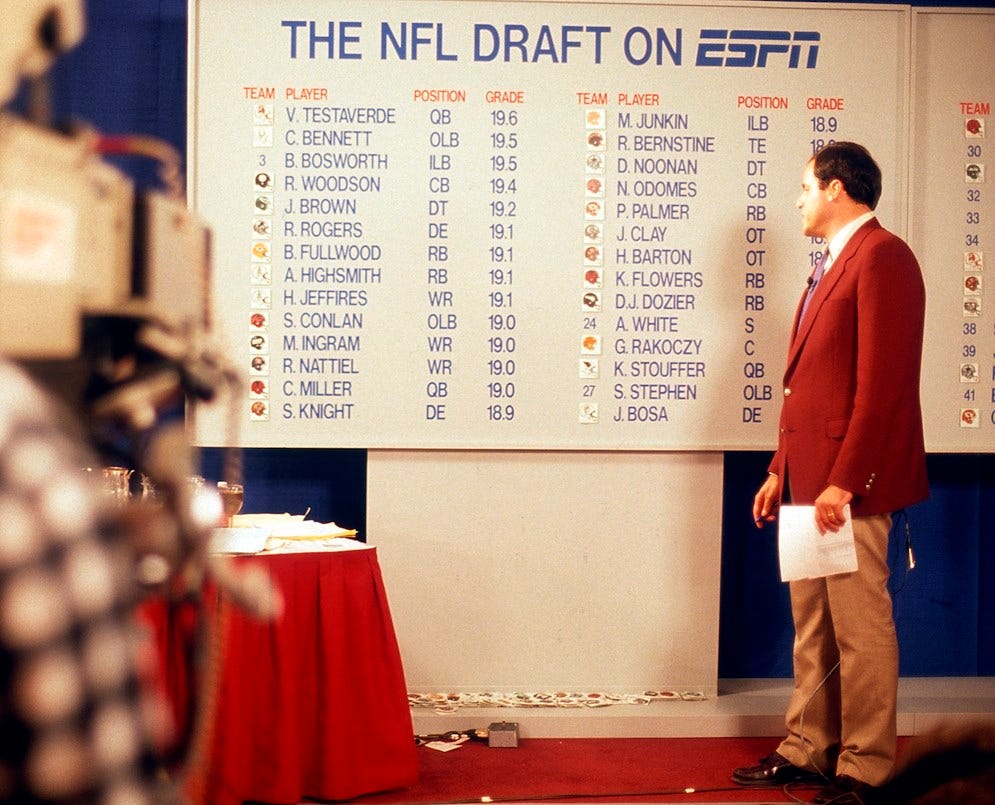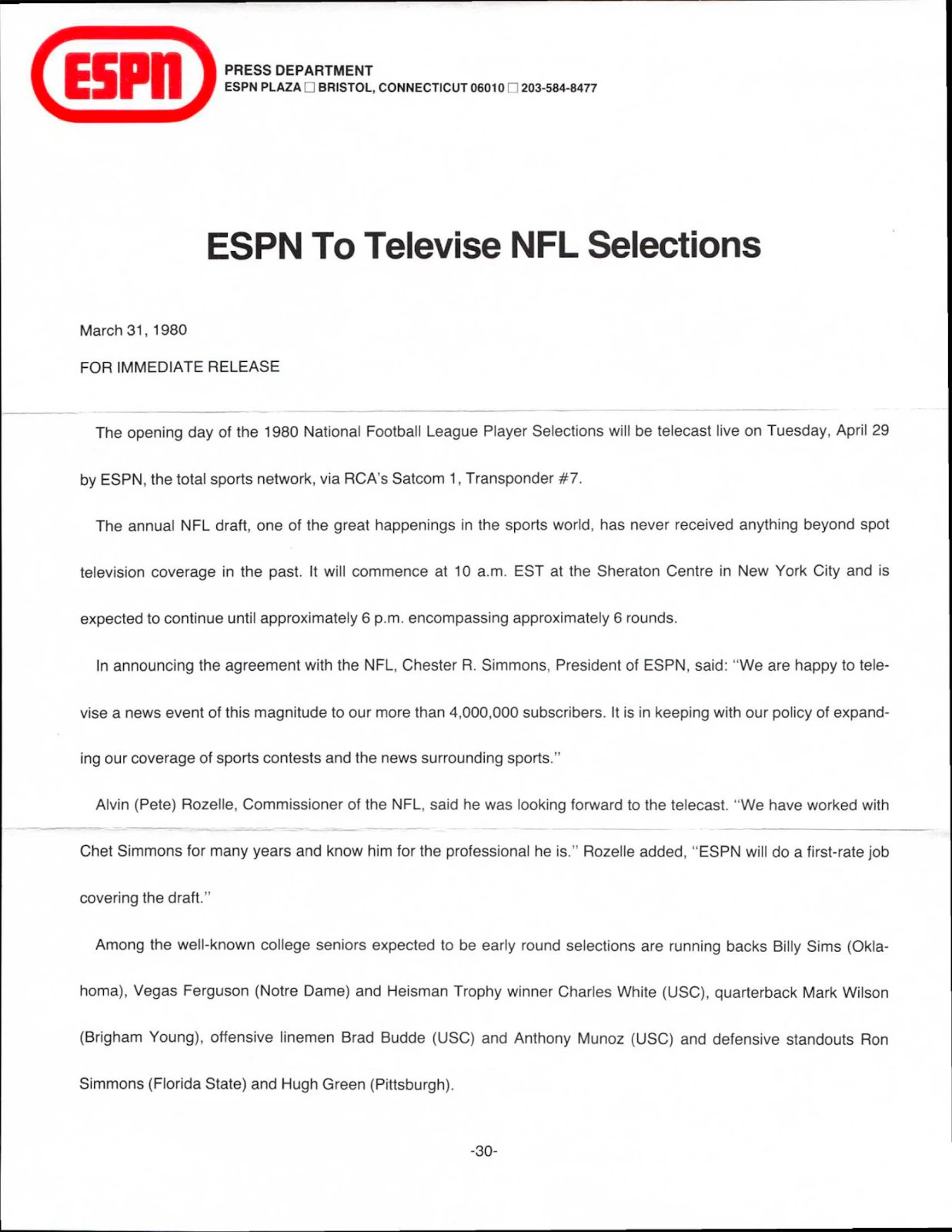See the NFL Draft Through the Years
A look at how the draft has grown to dominate TV for one weekend every April
In 1979, just a few months after its launch, ESPN executives sat in Bristol, CT, searching for ways to make their network stand out. ABC, NBC, and CBS already had the rights to the major sporting events, and besides, they were far too expensive for the upstarts. But even being attached to one of those leagues was better than nothing.
So ESPN president Chet Simmons called Pete Rozelle, then the NFL’s commissioner. Would the league allow ESPN’s cameras into the New York Sheraton to air the NFL Draft. Rozelle didn’t understand. “To Pete, it sounded like reading names from the phone book. Everyone said, ‘Who’s going to watch?’” remembered anchor Chris Berman.
But people did watch—and they’re still watching today. In 2017, 250,000 people attended the draft live with nearly fifty million more watching at home on coverage that spans across four channels. The draft has left hotel conference rooms for the glitz of the Vegas Strip. How did we get here? And how has the Draft changed over the decades? Join us in this special edition of The Word as we take a walk across the stages of NFL Draft history to see how America got hooked:
1935: In the early days of the NFL, teams could sign any new players that they wanted, which meant the rich got richer and the poor stayed poor. A few of the smaller teams protested, and the idea for an annual draft of college players began. Held in the Philadelphia Ritz Carlton, there were 10 teams and nine rounds (later expanded to 20 rounds in 1939), and the Eagles picked first. Their selection? UChicago’s Heisman winning tailback Jay Berwanger—who didn’t quite pan out. He never played a game for the Eagles; he figured he could make more money working in a rubber factory.
1965: The Draft was held behind closed doors, sometimes in secret. In its first decade, it moved around NFL cities like Chicago, Pittsburgh, and Milwaukee, but in 1965, it was held in New York, where it would stay for nearly fifty years. Here’s a photo of one of those early New York drafts, held in the Gotham Hotel.



1980: The year the draft was televised, although ESPN’s grand experiment barely registered with audiences at first. Its coverage only garnered one mention in a newspaper, a short column in the local Hartford Courant that declared: “NFL Draft Telecast. A Neat Experiment.”
1984: One person who was watching that first telecast was a 19-year-old named Mel Kiper Jr. A year earlier, before ESPN even existed, Kiper published his first NFL Draft guide. He wanted to be a scout, and he figured that specializing in the draft could get him noticed by an NFL franchise. “I remember doing radio shows when I was 18, 19 all over the country,” Kiper said last year. “Everybody at the time thought I was 40 years old. Nobody knew I was 18, 19. Nobody even asked.” In his first year, ESPN paid Kiper $400 to lend his expertise to the telecast.
1985: The Draft was ready for the big time. Well…the bigger time. Moving from the Omni Park Central to the Marriot Marquis—just off of Times Square. Here’s what it looked like:

1995: The Draft moved again, this time to the theater at Madison Square Garden.

2005: The Jets were rumored to be interested in building a stadium in Manhattan—but their plan was contested by James Dolan, the owner of Madison Square Garden and the Knicks. To punish Dolan, the NFL pulled the draft from MSG and took it to a convention center. But it would only stay there for one year.

2006: Time for the draft to head to Radio City Music Hall, home of the Rockettes. Throughout its time at Radio City, the draft was free to spectators—although they lined up for hours to get inside to watch and, typically, boo the Jets selection. For the first time in 2006, the draft was televised on NFL Network.

2015: The NFL wanted to expand the festivities to last for three days, but Radio City wouldn’t let them; it would interfere with the Rockettes’ schedule. So, the draft hit the road, where it’s been ever since. From 2015-2016, the draft was held in Chicago at the historic Auditorium Theater.
2017: Philadelphia hosted next, putting the draft stage on the famous Rocky Steps. It was the most attended draft in history, with over 250,000 people watching in person.

2018: All roads in the NFL eventually lead to Jerryworld. Tickets were once again free, but you had to win a lottery to get one. Over 100,000 crammed into AT&T Stadium in Arlington to watch.
2019: The draft headed to Nashville, where it was held on Lower Broadway. Just look how many people there were.

2020: Who can forget the famous remote draft, with Roger Goodell’s sweater, CeeDee Lamb’s second phone, and glimpses inside everybody’s houses?





Next year, it’ll head to Kansas City, and the year after that it’ll go to Detroit. Where should it go after that? Drop a comment and let us know.
🐐 The final episode of our series Man in the Arena is out now on ESPN+. I’ll be sharing my thoughts on the episode in a special edition of this newsletter next Tuesday. Until then, watch the episode here.
🎬 If you’re in New York this Saturday, check out the NYU Sports Film Festival, which we’re sponsoring, to watch student films that celebrate the power of sports. Learn more here.
🧘 The athleisure sector—with brands like Lululemon, Athleta, and Vuori—generated over $300 billion in sales last year. But do you know the humble history of the sports bra—and the friends turned enemies who created it?
⚽ Next Wednesday, the Seattle Sounders face the Mexico City-based club Pumas in the CONCACAF Champions League Final. A win would make the Sounders the first MLS team to ever win the tournament. Still not convinced you should watch? Try telling that to Marshawn Lynch.
🏀 For years, Springfield, MA, has been hailed as the birthplace of basketball. Herkimer, NY would like to have a word.










